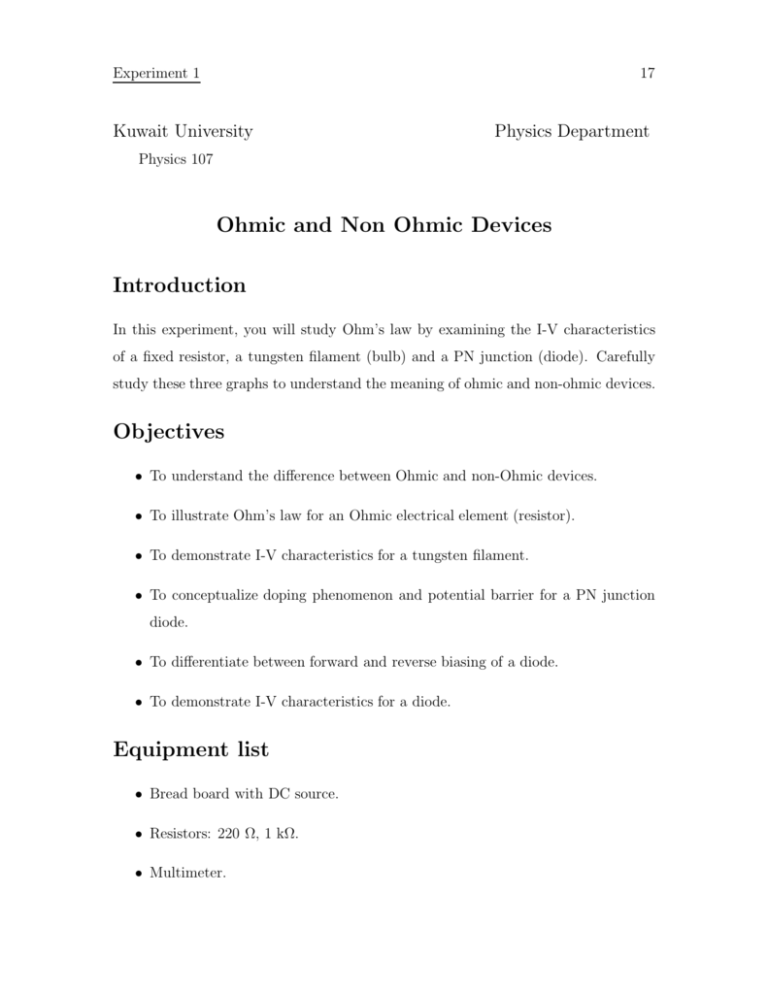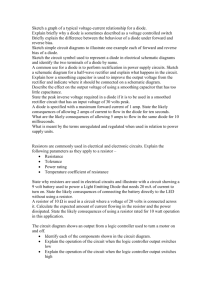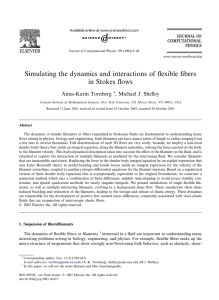Ohmic & Non-ohmic Circuits
advertisement

Experiment 1 17 Kuwait University Physics Department Physics 107 Ohmic and Non Ohmic Devices Introduction In this experiment, you will study Ohm’s law by examining the I-V characteristics of a fixed resistor, a tungsten filament (bulb) and a PN junction (diode). Carefully study these three graphs to understand the meaning of ohmic and non-ohmic devices. Objectives • To understand the difference between Ohmic and non-Ohmic devices. • To illustrate Ohm’s law for an Ohmic electrical element (resistor). • To demonstrate I-V characteristics for a tungsten filament. • To conceptualize doping phenomenon and potential barrier for a PN junction diode. • To differentiate between forward and reverse biasing of a diode. • To demonstrate I-V characteristics for a diode. Equipment list • Bread board with DC source. • Resistors: 220 Ω, 1 kΩ. • Multimeter. Experiment 1 18 • Tungsten filament (bulb). • Diode. • Wires. Theory Ohms Law: Ohm’s law states that the amount of current I flowing across a device is proportional to the voltage V that is applied across that device. Some devices such as resistors and wires obey Ohm’s Law. Mathematically, this can be written as V = IR (1) Where R, which is the constant of proportionality, is called the resistance of the device. The resistance, as the name implies, describes how difficult it is for the current to pass through the device. The higher the resistance, the lesser the current that flows through the device. R depends on the material, geometry and the temperature of the device. Figure 1 below, shows the voltage and current relation of a 330 Ω fixed resistor. The straight line shows that the resistance R is constant. The slope of the line gives the value of resistance. A computer drawn graph will give you the equation for the line. The coefficient of x gives the slope of the line. From the graph, the slope almost equals 330 and it represents the resistance of the device. You can find the slope manually as Slop = ∆V ∆I (2) Experiment 1 19 . Figure 1. V-I characteristics of a resistor Ohmic Devices: If a device follows ohm’s law for all voltages across it, the device is called an Ohmic device (In other words, the resistance of the device is independent of the magnitude and polarity of the applied potential difference), and the resistance is said to have a constant value (static resistance). In this case, the plot of V versus I is a straight line passing through the origin, as shown in Figure 1, and the slope of the line is the resistance R of the device. Non-ohmic Devices: If a device behaves in a way that is NOT described by Ohm’s law, (i.e. the resistance is not constant, but changes in a way that depends on the voltage across it.) The device is said to be non-Ohmic. In this case V versus I graph is not a straight line, but has some curvy shape. Such devices do not have a constant value of resistance and the resistance is called dynamic resistance because it is constantly changing. Examples of such devices are tungsten filament (bulb), diode, thermistor etc... Experiment 1 20 Filament (bulb): An incandescent light bulb with a tungsten filament has a positive temperature coefficient, and therefore has a very low initial resistance when the power is first applied. As the temperature of the filament increases, the resistance of the filament increases also. The temperature of the resistor increases by increasing the applied voltage, since the power dissipated as heat is increased due to the relation P = IV , where I is the current passing through the tungsten filament and V is the voltage applied across it. For metals, the number of free electrons is fixed. As the temperature increases, the amplitude of vibration of atoms/ions increases and collisions of electrons with them become more effective and frequent. As a result, current carrying electrons find more resistance in passing through and the resistance increases. Figure 2 shows the voltage and current relation of a tungsten filament. From the figure, it is clear that the resistance of the filament increases with applied voltage and the filament has a dynamic resistance. The resistance at A and B can be found by using R = V/I relation at that particular points and you can prove that RB > RA . Figure 2. V-I characteristics of a filament Experiment 1 21 PN junction Diode: As the name reflects, diode is a junction of P and N type semiconductors. Usually germanium and silicon are used to make diodes. P type and N type semiconductors are obtained by adding appropriate impurities to germanium or silicon (this process is called doping). Thus a P-type semiconductor has more free holes (hole is a vacancy of an electron) while an N-type semiconductor has more free electrons. Due to the different concentrations in P and N type materials, when a PN junction is formed, electrons from N side will diffuse towards P side while holes from P side will go towards the N side. The motion of the electrons and the holes results in the formation of a layer called depletion layer at the junction, also a potential barrier (or field across the junction) is formed. The width of this layer (or the barrier potential) determines the conductivity of the device. Forward biasing a diode: In forward biasing, the P side of the diode is set at a higher potential than the N side. Usually this is achieved by connecting the positive side of battery to the P side and the negative of battery to the N side of the diode. Diode will conduct in forward biasing because the forward biasing will decrease the depletion region width and overcome the barrier potential. In order to conduct, the forward biasing voltage should be greater than the barrier potential. During forward biasing the diode acts like a closed switch with a potential drop of nearly 0.6 V across it for a silicon diode and 0.2 V for a diode made of germanium semiconductor. Figure 3 shows the forward and reverse bias characteristics of a silicon diode. From the graph, you may notice that the diode starts conducting when the forward bias voltage exceeds around 0.6 volts (for Si diode). This voltage is called cut-in voltage. Experiment 1 22 . Figure 3. V-I characteristics of a Si diode Reverse biasing a diode: In reverse biasing, the N side of the diode is set at a higher potential than the P side. This can be obtained by connecting the positive of battery to the N side and the negative of battery to the P side of a diode. In reverse biasing, the diode does not conduct electricity, since reverse biasing leads to an increase in the depletion region width; hence current carrier charges find it more difficult to overcome the barrier potential. The diode will act like an open switch and there is no current flow (the reverse current is in the range of microamperes). From these characteristics of a diode, we conclude that the resistance of the diode is very small during forward bias and is very high during reverse bias. In addition, one may note that the resistance during forward bias depends on the forward bias voltage. Hence, we conclude that diodes are non-Ohmic devices. Experiment 1 23 Procedure Part one: Ohm’s law 1) Connect the 220 Ω resistor, DC voltmeter and a DC ammeter to the battery as shown in the Figure 4 below. Fix all of them on your bread board. Show your connection to your instructor before switching the power supply on. Figure 4. Circuit diagram to verify Ohm’s law. Also to find the value of an unknown R 2) Measure the voltage across the resistor VR and the current through the resistor IR for each of the power supply voltage Vs given in Table 1 below. Adjust the source voltage using the knob. Connect a voltmeter across the POS and GND terminals to measure the exact value while changing the knob. Experiment 1 24 Table 1. Ohm’s law. Vs (V) VR (V) IR (A) R= VR IR (Ω) 2 4 6 8 10 12 3) Using Ohm’s law, calculate the value of R from the table. While calculating R in ohms, voltage should be in volts and current in ampere. If not, do proper conversions. Average value of R = .......................................................................... Color-coded value of R = .................................................................... The tolerance limit of your R = .......................................................... Is your value within limits? (Yes OR No) ........................................... If no, explain : ..................................................................................... 4) Plot a graph of VR versus IR and determine the value of R from the slope. Slope = .......................................... R = .......................................... Does this match with the average value of R (yes OR no) .................. If no, explain : ...................................................................................... Experiment 1 25 Part two: The I-V characteristic of a tungsten filament 1) Connect the circuit on your bread board as shown in Figure 5 below. If you do not have two multimeters use a single multimeter to measure VR and VF . Show your connections to your instructor before switching the power supply on. Figure 5. circuit diagram for V-I characteristics of a filament. 2) Measure voltage VR across the resistor, and voltage VF across the filament for different Source voltages as shown in Table 2. Calculate IF using Ohm’s law and write on your table. Also, calculate resistance of the filament RF . Experiment 1 26 Table 2. I-V characteristics of a filament Vs (V) VR (V) IF = VR R (A) VF (V) RF = VF IF (Ω) 2 4 6 8 10 12 14 3) Plot a graph of VF versus IF and find the resistance of the filament at the two points A and B specified below: Resistance at A (VF = 1 V), RA = .......................................................... Resistance at B (VF = 3 V), RB = ........................................................... Which is greater RA or RB ? explain: ...................................................... .................................................................................................................... Experiment 1 27 Part four: The I-V characteristic of a PN junction diode. Forward biasing: 1) Construct the circuit as shown in Figure 6, using a potentiometer, 1 kΩ resistor and a silicon diode on the bread board. Show your connection to your instructor before switching the power supply on. Keep the source voltage around 10 V DC. Figure 6. circuit for forward biasing a diode. 2) Turn the potentiometer to control the input voltage (V12 ) applied to the diode and the resistor R (R = 1 kΩ). For different values for V12 , measure the voltage across the resistor VR and the voltage across the diode VD . Write your data in Table 3. Use your multimeter to measure V12, VR and VD as explained in the previous part. Experiment 1 28 Table 3. Diode forward biasing. V12 (V) VR (V) ID = VR R (A) VD (V) RD = VD ID (Ω) 0.2 0.4 0.6 0.8 1 2 3 4 5 6 Reverse biasing: 3) Reverse the direction of the power supply by interchanging POS and GND of your battery to obtain reverse biasing. This can also be achieved by interchanging the diode terminals in Figure 6. Repeat step 2 and record your results in Table 4. Do not forget to show your connections to your instructor before switching the power supply on. Experiment 1 29 Table 4. Diode reverse biasing. V12 (V) VR (V) ID = VR R (A) VD (V) RD = VD ID (Ω) 0.2 0.4 0.6 0.8 1 2 3 4 5 6 4) Plot ID versus VD for forward bias as well as reverse bias on a graph paper as shown in Figure 4. Compare your graph with the theoretical one. Understand the behavior of the diode during forward and reverse bias conditions. Also, see the change in resistance at different points. Again, from the graph we see that the diode does not adhere to ohm’s law. Explain why RD is high during initial forward bias? .................................... ...................................................................................................................... Experiment 1 30 Explain why RD is low when the forward bias voltage exceeds 0.6 volts? ...................................................................................................................... ...................................................................................................................... What is RD during reverse bias? Explain your answer. ...................................................................................................................... ...................................................................................................................... Results and Conclusion: Write the results you obtained from this experiment and your conclusions about the work you did including any suggestions or modifications to the experiment







